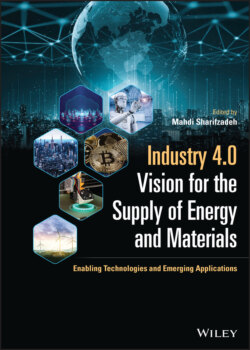Читать книгу Industry 4.0 Vision for the Supply of Energy and Materials - Группа авторов - Страница 48
1.5.3 4G Features Enhancement
ОглавлениеThe emerging IoT environment is composed of various types of wireless access nodes that require seamless connectivity [147]. The 4G network exploits interoperability and integration between multiple radio access networks (RAN) and radio access technologies (RAT) to create a more solid heterogeneous networking paradigm. This section briefly summarizes the evolution of 4G and its features that accommodate connectivity in IoT.
Coverage extension: Relaying is a key radio access technology in 4G that extends base station range beyond its coverage area [148]. A relaying service is composed of chains of relaying nodes that adopt a suitable transmission scheme (and spectrum) based on the required latency and reliability [149]. With reference to IoT systems, the adoption of relaying services decreases network overload, leading to improved network scalability. It also alleviates the single point of failure issue and provides some mean of fault-tolerant communications in IoT systems.
Enhanced data rate and throughput: 4G networks utilize the concept of licensed and unlicensed carriers’ aggregation, where control-related traffic and non-critical transmissions are sent via licensed and unlicensed bands, respectively. Such techniques can be beneficial for scalable IoT systems that require high throughput.
Power saving: As elaborated in 3GPP Release 12, frequent link quality measurements at the device side are a main source of energy consumption in networks. To address this issue, the power-saving mode was introduced as a viable solution to manage data transmission. In power-saving mode, a device could transmit uplink data at any time. However, for downlink communication, the device is reachable only either when it is active in uplink or is at configurable time instances.
RAN as a service: RAN utilizes radio resource virtualization to create various virtual functions and to expose them via cloud platforms to distribute networks functionalities and management [150]. Also known as RAN as a service, it improves the flexibility of the communication infrastructure and allows IoT systems to self-heal and self-configure.
Device-to-device (D2D) communication: It entails the possibility of data exchange between two devices in the unlicensed band without involving base stations or with just its partial aid [151]. In this technology, devices serve as mobile relays to communicate in IoT environment.
